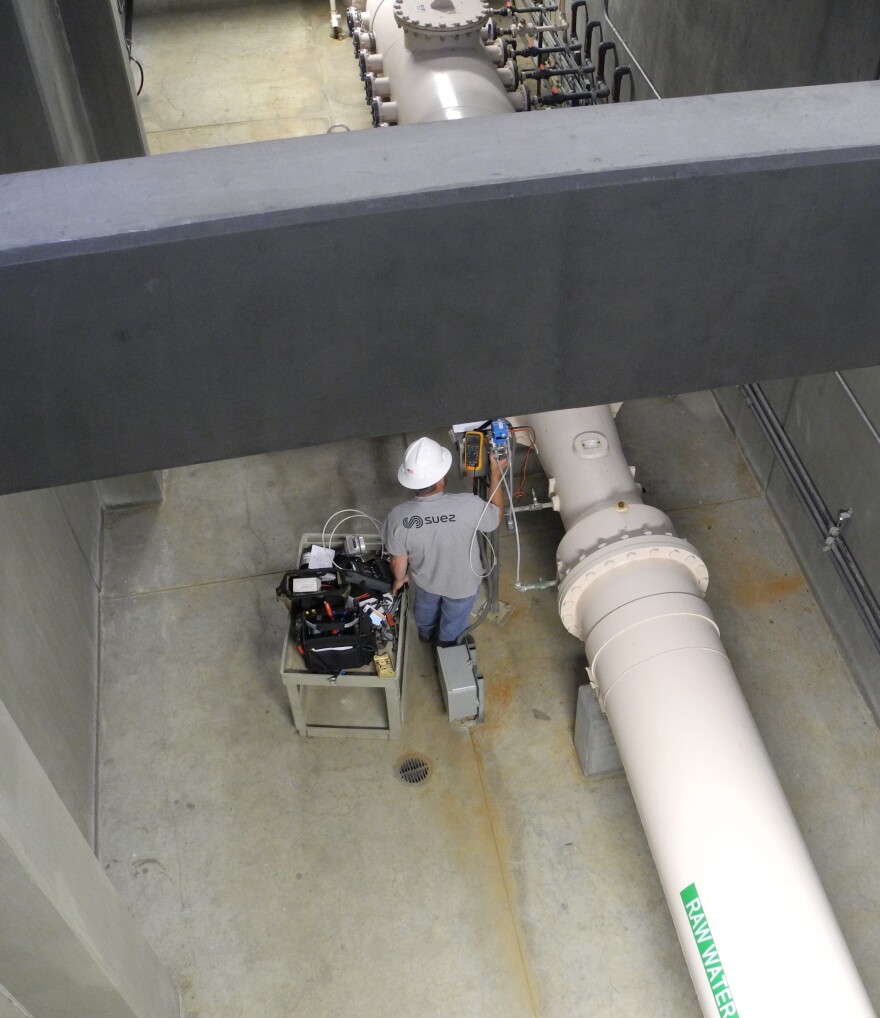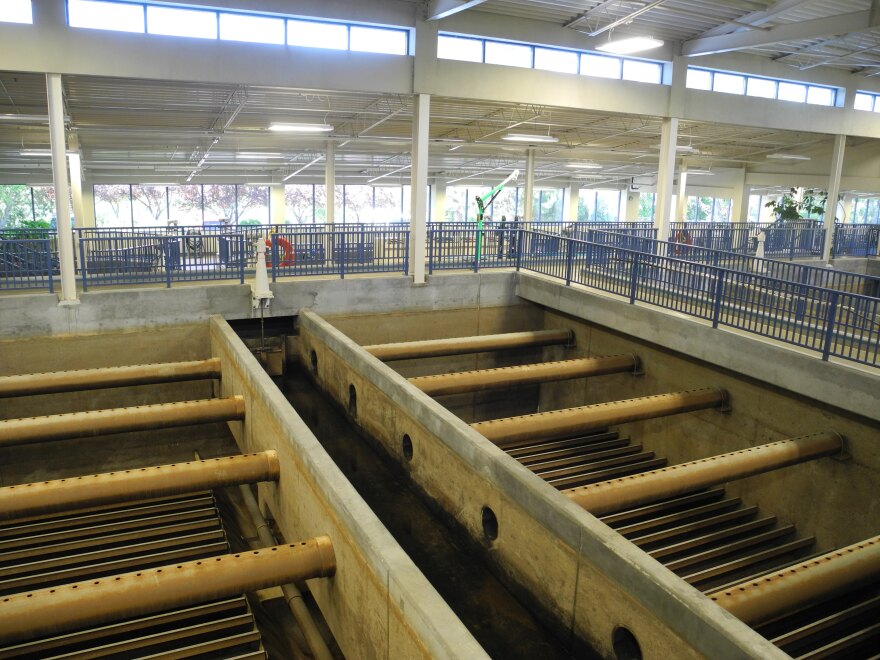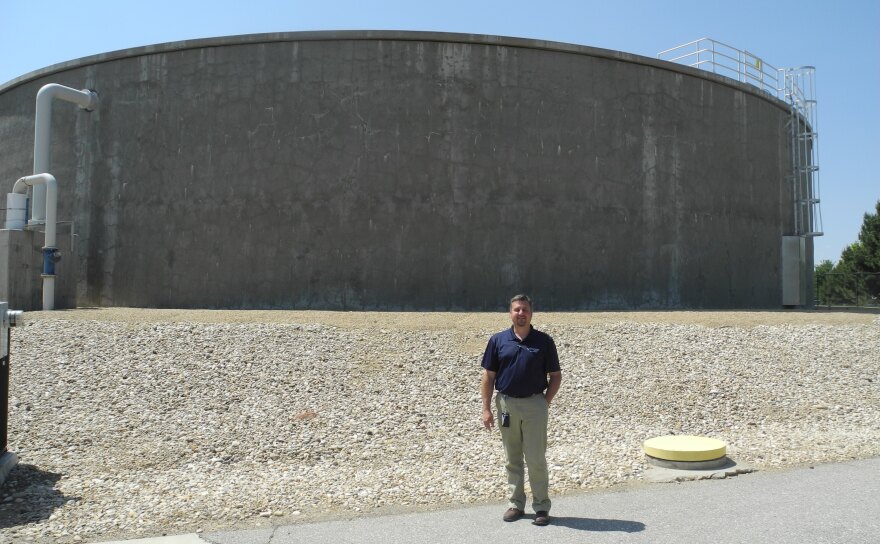When I turn on a sink I often wonder where the water is coming from. It turns out when I’m getting a drink in our newsroom kitchenette in east Boise I can see the answer through the window. It’s the Boise River. If I could go up the faucet and through the pipes I’d come out less than a mile upstream at the Marden water treatment plant off of Warm Springs Blvd.
Mark Snider with Suez, the multi-national company that supplies drinking water to most of Boise and some of Eagle says this was their first surface water treatment plant in Boise.
“We’ve subsequently added a second one on the hill near Micron,” Snider says.
Snider says about 30 percent of Boiseans get their water from the river through these two plants. The process starts with a big cylindrical structure that sticks out into the river.
“A lot of times you’ll see kids jumping off it in the summer months,” he says. “We discourage that. There are ‘no trespassing’ signs but people often don’t pay attention to those.”
I tell Snider I have jumped off it myself.
“OK, there you go," he says. "It’s a large concrete structure that goes down under the river bottom.”
Making Boise River Water Drinkable

Snider says little, hidden things like drinking straws take water from the floor of the river and pipe it into the treatment plant.
On the other side of the plant water also comes in through a canal that takes water out of the river further upstream.
It goes through filters on the way in and then a chemical called a coagulant is added. That’s like glue and tiny particles in the water stick to it.
Then the water is pumped into an airplane-hanger-sized room where it's filtered again.

Then it’s pumped into concrete pools. It sits in the pools for a while so the last of the gunk can float to the top.

It goes through one more filtration, then it’s pumped out to a huge underground tank and chlorine is added. It has to sit in the tank for a while, but then it’s sent to homes and businesses in east and northeast Boise as well as downtown.
This is not the only way to treat surface water for drinking. In fact, Suez’s other Boise plant uses an entirely different method.
Surface Water
Nationwide, the majority of drinking water is what's called surface water. It comes from rivers, lakes even the ocean in some places. But Jerri Henry, the drinking water program manager at Idaho’s Department of Environmental Quality, says in Idaho only 5 to 10 percent of drinking water comes from rivers or lakes. Henry says the reason is simple.
“It’s really expensive to treat surface water to drinking water standards,” Henry says. “You’re getting a lot of microorganisms and that’s what you’re trying to treat for, you know, your cryptosporidium, your giardia.”
Henry says even apparently pristine Idaho mountain stream water would have to be treated in order to meet municipal drinking water standards.
Idaho doesn’t use much surface water for drinking because we don’t have to. Most of the state has access to water that doesn’t require nearly as much work and money to make it drinkable.
So, Where Does The Other 90 To 95 Percent Of Idaho's Drinking Water Come From?
To find out, I go to Meridian to a garage-sized building on the edge of a city park. Dennis Teller is Meridian’s water superintendent. Over a horrible screaming sound from one of three pumps in the room, Teller explains what we’re seeing.
“So this is well 20,” Teller says. “We pump the water from the ground and outside to the reservoir.”
The reservoir Teller mentioned is a 2-million-gallon concrete tank just a few yards away. All of Meridian’s drinking water comes from an aquifer. These porous layers of rock are like giant underground sponges. Meridian has 23 wells drilled down into that sponge, and outside the noisy pump house Teller says because of the city’s rapid growth, most of those are only a few years old.

“We have been drilling wells continuously,” Teller says. “We’re actually in the process of drilling three new wells. Luckily we’re not seeing any issues with the ground water supply.”
Idaho’s aquifers are the reason the state has more abundant and cleaner drinking water than much of the West. All the drinking water in Eagle, Garden City, Nampa and a lot of other cities comes from aquifers. Most of Boise’s does too.
Why Use Some Surface Water in Boise?
Suez has more than 80 wells that supply 70 percent of Boise’s water. But Suez’s Mark Snider says there are a couple reasons the company does not rely entirely on groundwater. He says there are restrictions on aquifer access in east and southeast Boise. Plus, he says it gives the company more flexibility for things like spikes in demand.
“We can ramp up and expand both treatment plants if necessary,” Snider says. “We can’t always drill another well.”
Snider says the Boise River is cleaner and easier to treat than many of the surface water sources used in other parts of the country. But it still requires a lot more work and expense than groundwater.
Why Groundwater Is Cheaper
Boise does add chlorine to its groundwater before sending it to homes as a precaution. So does Meridian. But Jerri Henry with the DEQ says most of the nearly 800 municipal drinking water systems they monitor ... don’t.
“Most don’t have to do anything,” Henry says. “Typically your groundwater sources are already filtered, kind of through the ground. So most of those aren’t needing to be treated.”
Idaho’s huge underground water reserves have played a major role in making the state what it is today. They’ve fueled the agricultural economy. And they’ve made the rapid population growth of the Treasure Valley possible.
However, there are serious concerns about depleting aquifers in Idaho as well as aquifer pollution. Those are issues we explore elsewhere in our series Watering Idaho.
Find Adam Cotterell on Twitter @cotterelladam
Copyright 2016 Boise State Public Radio



